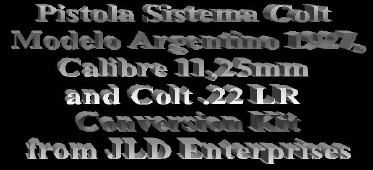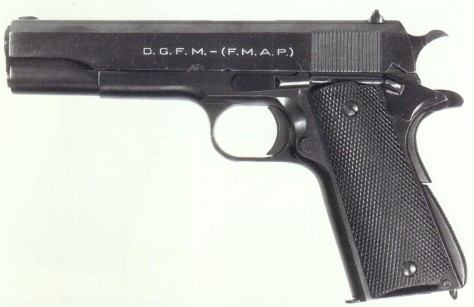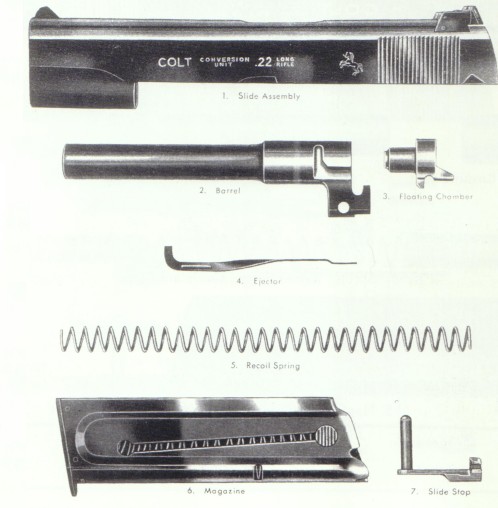CRUFFLER.COM
presents
FIREARM
REVIEW,
June
2000:
 |
 |
 |

|
Type:
Self loading pistol
System of Operation: Recoil Caliber: 11.25x23mm (.45 ACP) Capacity: 7 round box magazine Sights, front: Fixed blade Sights, rear: Drift adjustable notch Length: OAL 8.62", Barrel 5" Weight: 2.43 lbs Retail Price: $350.00 |
 |
Type: Sub-caliber
conversion unit
System of Operation: Blowback Caliber: .22LR Capacity: 10 round box magazine Sights, front: Fixed blade Sights, rear: Fully Adjustable Colt Accro Length: OAL 8.5", Barrel 5" Weight: 1 lb Retail Price: $500.00 |
In 1943, the Argentine Military Small Arms Factory (FMAP - Fabrica Militar de Armas Portatiles) began to prepare for the manufacture of Model 1927 pistols under the 1927 licensing agreement. These pistols were known as "Pistola Sistema "Colt" Modelo Argentino 1927, Calibre 11,25mm." Production began at the Esteban de Luca Arsenal in Buenos Aires, with the first pistols actually being assembled at the Domingo Matheu plant in Rosario, Argentina in 1945. The pistols were manufactured in accordance with Colt's 1927 drawings. They were exact copies of Colt's 1927 pistols (identical to US military M1911A1 pistols) except for very minor differences, and parts were interchangeable. The only noticeable differences were the markings, grips, black oxide bluing, a sharp edge on the rear of the hammer, and a sharp edge on the heel of the grip safety. Triggers were solid as on the 1927 Colts , and the checkering on the mainspring housing was changed from Colt type cut checkering to indented checkering.
Barrels on pistols issued to the Army had blued chambers, but the chambers on Navy, police, and commercial barrels were milled after being blued, which resulted in a bright unfinished surface comparable to Colt commercial barrels. Serial numbers were stamped on the barrels prior to bluing, and therefore, bluing remained inside the numbers.
The Sistema Colt pistols were made for the army, navy, air force, government bureaus, police organizations, and commercial sales. They were normally serial numbered on the right side of the receiver, the grip frame under the mainspring housing, on the top and right side of the slide, on the top of the chamber and the bottom of the magazine. The presence of an Argentine crest on the pistol indicates government issue; pistols without crests were made for local police, non-government agencies, commercial sales and export. All Sistema Colt pistols bear the marking D.G.F.M. - (F.M.A.P.) on the left side of the slide, which indicates manufacture by the Direccion General de Fabricaciones Militares at the Fabrica Militar de Armas Portatiles. A total of 88,494 Sistema Colt pistols were produced.
THE
US COLLECTOR MARKET
There
has always been a market in the United States for M1911A1 style pistols,
as is evidenced by the continuing strong sales of such pistols, the plethora
of "new" models that are brought out every year, and the huge aftermarket
parts and customization industry that has grown up around the venerable
.45. The problem has been that while the nature of the pistols hasn't
changed much since 1927 when the 1911A1 was introduced, the cost has uniformly
increased over the years, to the extent that it is hard to buy even a used
1911A1 style pistol for less than $400, and new guns can run into the thousands
of dollars. As a result, many US shooters and collectors who have
long wanted a ".45," have been daunted by the steep prices.
However, with the recent importation of large numbers of Argentine military
.45's, the wait may just be over!
Farmington, Connecticut based JLD Enterprises, Inc. is currently importing military surplus firearms and accessories from South and Latin America, including Argentine military pistols, at very reasonable prices. Not being immune to ".45 Fever," we rang them up and ordered an "arsenal refinished" Sistema Colt pistol as well as an original Colt .22 LR conversion kit.
PRODUCT
REVIEWS - The Sistema Colt
Two
days after we placed the order, the BBT
arrived, bearing the pistol and the conversion kit.
We opened the pistol box first, and were quite pleased. The Sistema inside looked to be almost new. It had been refinished in an attractive matte black that was akin to either bluing over a bead blasted surface or a very fine parkerizing. It did not feel rough to the touch and shone with that dull gleam that seems common to the current crop of "combat" pistols that are finished with proprietary matte coatings. The markings had not been obscured or blurred at all by the refinishing process. Interestingly, this pistol had no crest or organizational markings on the right side of slide, indicating probable issuance to a local (i.e. non-federal) police agency. The chamber portion of the barrel was unfinished and unmarked save for the serial number, and the bright surface showing through the ejection port contrasted nicely with the dark slide. Grips were typical brown GI checkered plastic. Barrel, slide, and frame serial numbers all matched. The only part of the pistol that didn't measure up was the magazine - it had obviously not been refinished and had been around the block once or twice, with evidence of significant shaping and reshaping of the feed lips. All in all, the pistol was as nice as any of "GI style" guns currently on the market, and for a considerably smaller investment!
An internal inspection revealed operating parts that showed little or no wear. It is our surmise that the pistol had been refurbished as well as refinished at the arsenal prior to export. The barrel was a little dirty, but cleaned up well so that it shone and displayed nice sharp rifling - not new, but so close as to not matter. None of the springs demonstrated any tendency toward losing their temper; indeed, most functioned and felt as though they were new.
PRODUCT
REVIEWS - The Colt Conversion Unit
When
we opened the box containing the Colt conversion unit, we were just as
pleased as when we opened the Sistema. Finish was the original Colt
blue, with approximately 95% if not more, remaining. The bore on
the conversion barrel looked to be almost new. The slide assembly
was equipped with a Colt Accro fully adjustable rear sight. For those
readers not familiar with the Colt .22 LR conversion unit, some explication
is in order.
The kit consists of eight parts: Slide assembly, barrel, barrel bushing, floating chamber, ejector, recoil spring, magazine and slide stop. With the exceptions of the floating chamber and the ejector, each of these replaces a corresponding part on the original .45 ACP pistol. The ejector operates independently of the original ejector, and is necessary due to the different dimensions of the .22LR and the .45 ACP. The floating chamber is also worth a few lines. At first glance it would seem very difficult to build a 1911A1 style pistol that would work with the relatively low powered .22LR round, and still retain the weight and dimensional characteristics of the original gun. This was accomplished by making the chamber of the gun a separate piece from the barrel, in the form of a hollow piston fitting into the rear end of the barrel. When the gun is fired, the gas of the explosion gets into the space between the face of the chamber and the rear of the barrel, and the pressure of this amount of gas is sufficient to force the chamber backward with enough recoil to cycle the operating parts of the pistol. Additionally, the action of the floating chamber provides a very good imitation of the recoil experienced with actual .45 ACP cartridges.
Shooting
the Sistema Colt
Well,
everything LOOKED good. The question was whether it would shoot as
good as it looked. We gave one of our field testing staff the Sistema
and some .45 ACP ammunition, and trundled him off to the NRA range to find
out.
Ammunition
We brought
along some representative ammunition with which to test the pistol, to
include some Federal American Eagle 230 grain Full Metal Jacket (FMJ),
Winchester USA 230 grain FMJ, and some National Bullet Company reloaded
230 grain FMJ. As this was a military pistol built on the lines of
the 1927 M1911A1 pistol, we tested it only with the ammunition for
which it was designed - i.e., the 230 grain FMJ .45 ACP round.
Accuracy
We used
a standard NRA B-2 target with a 3" black center. Shots were fired
at a uniform range of 40 feet. Given the combination of pistol, sights,
and shooter we felt that this distance would enable us to get an idea of
how the pistol was shooting. Firing seven shot groups (one magazine
full), the results were nicely consistent. The groups all clustered
about 1" to the right and 1.5" above the point of aim.
We were happily surprised with the group sizes. After our tester,
who tends to carry or shoot more 9x19mm pistols than .45 ACP pistols, got
used to the Sistema's recoil and grip, most groups were gratifyingly
tight. The best group of the day was turned in using the Federal
American Eagle cartridges, and was a seven round cluster that could be
covered with a half-dollar coin. For our money, we don't believe
that there is much more one can ask from a new in the box pistol, much
less a refurbished service pistol!
Recoil
No surprises
here - the .45 ACP cartridge generates a good deal of recoil. Certainly
not in the class of a .357 Magnum, but more than enough to get your attention,
and to require the shooter to devote a bit of time to both live practice
and dry firing. That being said, the recoil was not unpleasant.
The gun's weight and shape do go a long way towards reducing the recoil
sensation. Recoil sensitive shooters need not fear the .45,
as the cartridge generates a recoil that is more a push or shove than the
hard slap associated with the magnum calibers.
Reliability
We fired
about 200 rounds in the course of the range session and experienced a total
of four failures to feed. All four of these failures were directly
attributable to the well worn magazine that came with the gun. When
we switched to a Mec-Gar magazine brought as a "control" for exactly these
circumstances, we experienced no further failures. Our take on this
is that purchasers of a Sistema may wish to invest in a few aftermarket
or GI magazines so as to eliminate this potential problem.
Fired cases were inspected and showed no signs of excessive pressure or
any other irregularities.
Shooting
the Colt Conversion Unit
Once
we finished test firing the Sistema in .45, we installed the .22LR conversion
kit. Installation took a whopping three minutes - it is no more difficult
than field stripping an M1911A1. The magazine deserves special note:
Most of the magazines that we have handled for .22LR autoloaders appear
to be flimsy and fragile. Nothing could be further from the truth
with respect to conversion kit's . It was substantial, well made,
easy to load, and durable. The magazine spring was equipped with
a loading button to help depress the follower. It was easy to use,
unlike the "thumb busters" on many other magazines of this type.
Ammunition
We brought
along several different types of .22LR ammunition with which to test the
conversion kit, to include some Winchester Dynapoint Jacketed Hollow Point
(JHP), and a variety of PMC and Remington lead round nose (LRN) ammunition.
Some of the ammunition was newly purchased, and some had been sitting on
our shelves for several years.
Accuracy
We used
a standard NRA B-2 target with a 3" black center. Shots were fired
at a uniform range of 40 feet. Given the combination of pistol, sights,
and shooter we felt that this distance would enable us to get an idea of
how the pistol was shooting. Firing ten shot groups (one magazine
full), the results were at first disappointing. To say that we were
all over the paper would have been charitable! However, once we sat
down and considered what was being done, it became obvious that the errors
were the fault of the shooter, and not the arm.
It boiled down to this: Our tester's experience with .22LR autoloaders had been limited to target pistols with minimal to no recoil and featherweight triggers such as High Standards, Ruger Mk. II's, and Browning Buckmarks. Consequently, when firing the conversion, he completely changed his shooting methodology from that he had been using with the Sistema in .45 ACP. The problem with this approach is that the conversion kit duplicates just about every facet of shooting the .45 ACP, to include the service pistol's trigger pull and recoil. In other words, to shoot the conversion successfully, one had to use the same technique as was used with the .45 ACP version.
When our tester began to shoot the .22LR as he would the .45 ACP, the groups tighened up considerably to the extent that his best group, fired with the PMC ammunition, was nicely centered on the bull's eye and could be covered with a quarter! Not bad at all for a conversion unit placed onto a randomly selected service pistol!
Recoil
The
conversion kit's recoil was unlike any .22LR we'd ever fired.
Not that it was hard or unpleasant; the issue was that there *WAS* recoil
in the first place. Indeed, the pistol would jump as if one were
firing a .45! While this didn't detract from the gun's accuracy,
it made for a unique experience. We believe that this makes the conversion
kit an excellent training tool for those who wish to practice a great deal
without the expense of .45 ACP ammunition.
Reliability
We fired
about 250 rounds in the course of the range session and experienced no
failures to feed. This makes the conversion kit unique in our experience
as regards .22LR autoloading pistols; every other self loading .22LR pistol
we've fired has had failures to feed, extract, or eject. Function
on the conversion kit was perfect! Fired cases were inspected and
none showed any signs of excessive pressure or any other irregularities.
We did experience many misfires and failures to fire. All of these failures were associated with the Winchester ammunition, which had been on our shelves for over four years. None of the other brands demonstrated similar failures. We feel safe in saying that any failures to fire or misfires were attributable to the ammunition and not to the conversion unit or pistol.
CONCLUSION
If you
have long wanted a military M1911A1 style pistol but have been put off
by the expense, then the Sistema Colt's represent the value and quality
you have been searching for! These are excellent shooters with an
interesting history behind them, at a reasonable price. Our advice
is to "jump on these!"
For the advanced Colt collector, the .22LR conversion kit represents a wonderful opportunity, and should not be overlooked.
Overall, JLD's South American imports represent some of the best values and most interesting pieces of military surplus that have come into the country in recent years.
If you have any questions about where and how to go about acquiring either a Sistema Colt pistol or a Colt .22LR conversion kit, JLD Enterprises.
And now,
our Buy-O-Meter rating for the Sistema Colt pistol:
 |
And now,
our Buy-O-Meter rating for the Colt .22 Conversion Unit:
 |